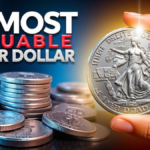Introduction
For collectors and currency enthusiasts, rare $1 star notes hold significant value beyond their face worth. These bills, marked with a star (*) next to the serial number, indicate that they were replacement notes issued by the Bureau of Engraving and Printing (BEP) to replace defective bills. While all star notes are somewhat scarce, certain series and print runs are exceptionally rare and can be worth hundreds or even thousands of dollars.
In this article, we will explore the history of star notes, why they are valuable, and the five most sought-after $1 star notes that collectors should be on the lookout for. Additionally, we will provide a table summarizing key details about these valuable bills, tips for identifying star notes, and answers to frequently asked questions.
What Are Star Notes and Why Are They Valuable?
Star notes are replacement banknotes issued by the BEP when a printing error occurs. Instead of reusing the same serial number, the new bill is printed with a star (*) at the end of the serial number. The rarity and value of a star note depend on several factors:
- Low print runs – The fewer printed, the rarer the note.
- Age of the note – Older notes tend to be more valuable.
- Condition – Notes in pristine, uncirculated condition fetch higher prices.
- Unique serial numbers – Fancy or repeating serial numbers increase a bill’s worth.

5 High-Value $1 Star Notes to Look For
Below are five of the most valuable $1 star notes that could be hiding in your wallet, collection, or even in circulation.
1. 1928 $1 Silver Certificate Star Note
- Why it’s valuable: This is one of the earliest $1 star notes ever issued, making it highly collectible.
- Estimated value: $500–$2,500 depending on condition.
- Key features: Blue seal, silver certificate designation, and a small star next to the serial number.
2. 1935A North Africa $1 Star Note
- Why it’s valuable: Issued during WWII for military use, this note is rare due to its historical significance.
- Estimated value: $750–$5,000 depending on condition.
- Key features: Yellow seal, silver certificate label, and star replacement serial number.
3. 1957 $1 Silver Certificate Star Note
- Why it’s valuable: As one of the last silver certificate issues, it is a must-have for collectors.
- Estimated value: $100–$1,000 based on grade.
- Key features: Blue seal, silver certificate printing, and star serial number.
4. 1988A Web Press $1 Star Note
- Why it’s valuable: The BEP experimented with Web Press printing, resulting in a limited number of these rare notes.
- Estimated value: $500–$3,000 for uncirculated notes.
- Key features: Star at the end of the serial number, special Web Press characteristics.
5. 2013 B New York District $1 Star Note*
- Why it’s valuable: Due to a unique printing error, some 2013 B* star notes are extremely rare.
- Estimated value: $300–$2,000 based on condition.
- Key features: Green seal, Federal Reserve Note designation, and a rare print run.

Table: Summary of High-Value $1 Star Notes
| Year | Type | Seal Color | Estimated Value |
|---|---|---|---|
| 1928 | Silver Certificate | Blue | $500–$2,500 |
| 1935A | North Africa Note | Yellow | $750–$5,000 |
| 1957 | Silver Certificate | Blue | $100–$1,000 |
| 1988A | Web Press | Green | $500–$3,000 |
| 2013 | Federal Reserve | Green | $300–$2,000 |
How to Identify Valuable Star Notes
To determine if your star note is valuable, follow these steps:
- Check the serial number: Look for a small star (*) at the end of the serial number.
- Verify the series and year: Compare your note’s year with the list above.
- Assess the condition: Uncirculated notes with no folds or creases are the most valuable.
- Research the print run: Lower print run numbers indicate greater rarity.
- Consult collector guides: Online databases and currency collectors’ price guides provide up-to-date valuations.
Where to Sell or Buy Rare Star Notes
If you own a valuable star note, consider selling it through:
- Online auction sites (e.g., eBay, Heritage Auctions)
- Currency dealers specializing in rare banknotes
- Collector forums where enthusiasts discuss and trade notes
- Coin and currency shows where professional appraisals are available
Conclusion
Rare $1 star notes can be hidden treasures worth significantly more than their face value. By understanding what makes certain star notes valuable, collectors can identify potential high-value bills and take advantage of the growing interest in paper money collecting. If you have a star note, research its background, condition, and market demand to determine its worth. Who knows? You may have a hidden gem in your wallet right now!
For the latest updates on rare star notes, keep an eye on collector marketplaces and auction sites. Happy collecting!
FAQs
1. How do I know if my $1 star note is valuable?
Check the serial number for a star (*) at the end, confirm the year and series, and look up recent auction prices to determine value.
2. Are all star notes worth more than face value?
No, common star notes with high print runs may only be worth face value, while rare series can fetch hundreds or thousands of dollars.
3. Can I still find valuable $1 star notes in circulation?
Yes, although rare, it is possible to find valuable star notes in everyday cash transactions.
4. Should I keep my star note in a protective sleeve?
Yes, storing star notes in a protective sleeve helps maintain their condition and value.
5. Where can I check current star note values?
Websites like Heritage Auctions, Paper Money Guaranty (PMG), and currency collector forums offer updated price guides.















